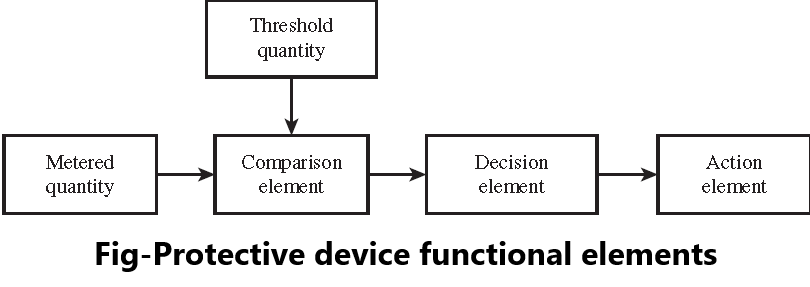The protection device usually consists of several elements that are arranged to test the system condition, make decisions regarding the normality of observed variables, and take action as required. These elements are depicted graphically in Figure.

The protective system always measures certain system quantities, such as voltages and currents, and compares these system quantities, or some combination of these quantities, against a threshold setting that is computed by the protection engineer and is set into the device. If this comparison indicates an alert condition, a decision element is triggered. This may involve a timing element, to determine the permanence of the condition, and may require other checks on the system at other points in the network. Finally, if all checks are satisfied, an action element is released to operate, which usually means that circuit breakers are instructed to open and isolate a section of the network.
The time required to take any necessary corrective action is called the clearing time and is defined as follows:
Tc = Tp + Td + Ta
where
Tc = clearing time
Tp = comparison time
Td = decision time
Ta = action time, including circuit breaker operating time
The clearing time is very important for a variety of reasons. These reasons are elaborated on in the following paragraphs.
Timing is important to facilitate coordination with other devices. Since other protective systems in the network may be time-coordinated with this protective device in order to ensure that only the necessary portions of the network are interrupted. There is an important message here, namely, that many protective devices will observe a given disturbance and many of them will find that disturbance to exceed their threshold settings. Each device should have some kind of restraint to allow those closest to the disturbance to trip first. Time is one kind of restraint that is often used. Other restraint mechanisms will be discussed later.
Fast clearing time is also important because some disturbances, such as short circuits, must be cleared promptly in order to preserve system stability. This depends on many factors, including the location and type of disturbance. However, it is a general rule that abnormal system conditions must be corrected, and speed of correction is always important.
Power quality is affected by short circuits. The voltage on faulted phases often drops below acceptable minimum values for good power quality. In some cases, the voltage on unfaulted phases may also rise above unacceptable maximum values. Therefore, short clearing times are required to minimize the negative impact of short circuits on power quality.
Short circuits also cause problems to power system equipment and expose adjacent personnel and property to hazards. Damage to faulted equipment will often be reduced if a short circuit is cleared promptly. Such prompt clearing may make the difference between repairable and unrepairable equipment. The high current flowing into the short circuit may also cause damage to unfaulted equipment supplying the fault current.
Damage could be caused if the short time overload capability of the unfaulted equipment is exceeded. Further there is often arcing associated with short circuits. In many cases, the energy released by the arc is very high. The arc energy exposes nearby property and personnel to hazards. Injury due to arc flash is a well-recognized hazard to personnel working around electric power equipment. This arc flash energy is directly proportional to the duration of the short circuit.
Finally, high values of short circuit current flowing through the ground may cause significant voltage drops across short portions of grounded equipment. These voltage drops also expose personnel to hazards, commonly referred to as step and touch potential hazards. Substation equipment grounding is usually designed to maintain acceptable maximum values of step and touch potentials. However, for short circuits to ground in public areas, excessive step and touch potentials are possible. Therefore, minimizing the short circuit duration for short circuits in publicly accessible locations will minimize step and touch potential hazards to the public.
